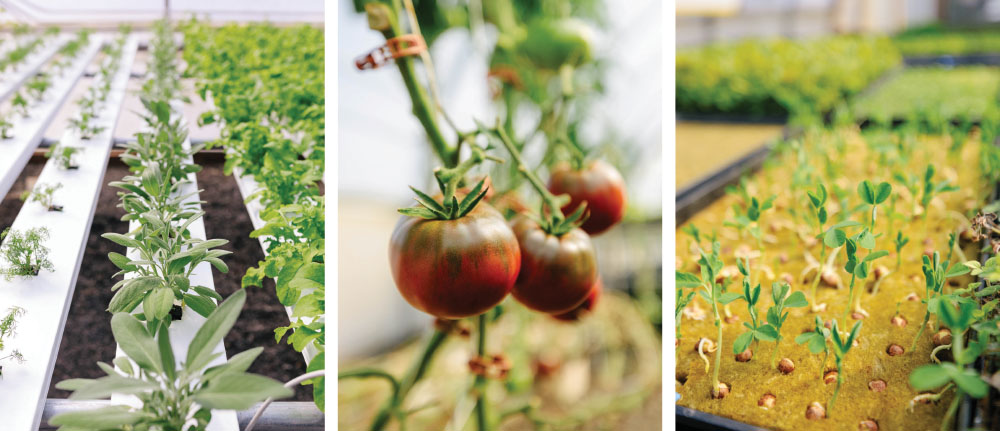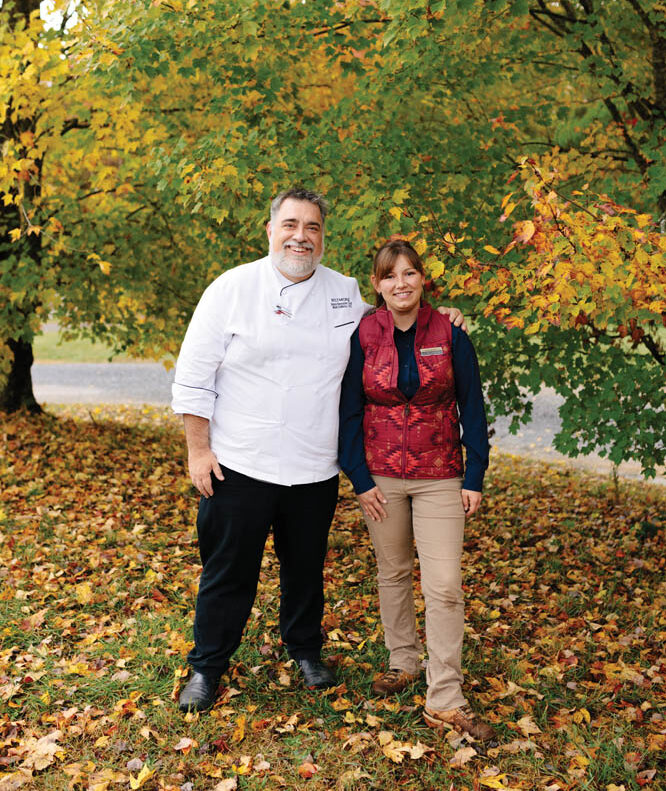
The expanded hydroponics program at Biltmore yields locally grown produce in any season. Photos by Rachel Pressley.
Most who visit Biltmore are familiar with the sprawling 4,000 acres that encompass the grand house, the floral gardens and conservatory, the winery, and the landscaped paths. But across the French Broad River, on the Western side of the estate, there’s another spread of 4,000 acres — the hidden, working side that is closed to the public (except for select tours). It serves as the agricultural hub of Biltmore, and it’s where Sarah Woodby manages three hydroponic greenhouses.
The innovative gardener — who grew up on a tobacco farm in Yancey County and taught horticulture at Mayland Community College — took over the hydroponics program in 2021 after the two previous caretakers of 30 years retired during the Covid-19 shutdown. When she inherited the greenhouses, they were only used to grow microgreens, but Woodby has drastically expanded their systems to cultivate a wide variety of crops that service the estate’s multiple culinary venues, including six sit-down restaurants.
Biltmore Executive Chef Mark DeMarco marvels at how far the gardener has pushed operations to another level. For instance, Woodby implemented a channeled system called NFT— Nutrient Film Technique — that involves a thin layer, or “film,” of fluid that is rich with macro and micro nutrients. The nourishment is pumped under the plant roots day and night.
“Sarah and Kyle Mayberry, our director of agriculture, have grown the programs that were already in place and greatly enhanced them to what you see now,” says DeMarco.

You grew up farming tobacco with your family. How did you wind up in hydroponics?
Sarah Woodby: Tobacco is so labor intensive, and there were some days where the hours were just unreal. As a child, it was just miserable. But after the tobacco buyout, my parents had all of these greenhouses that they grew tobacco transplants in. So they started a garden center and grew all kinds of seasonal annuals and perennials. I loved working in those greenhouses when they were full of vegetable transplants, and it really showed me what agriculture could be.
Describe what’s different about hydroponic farming …
SW: It’s just the method of growing plants without any involvement of soil or dirt. That being said, you also remove a lot of the organic microbial interactions at the root zone. So everything here has roots that are suspended in a medium or substrate of some sort — [insulation materials such as] Rockwool or Perlite are used a lot in our systems. So your produce is cleaner, and you have a lot of control not only of the surface of your crop, but over the root environment. And as a result, you get a crop that produces about 40% faster, gets 40% larger, and uses 40% less water than traditional field-grown crops. Put it under a roof, put in a couple grow lights and some ventilation, and we can grow year round. We create our own seasons.
So what are you able to produce out of these two greenhouses?
SW: We do as much as we can with a little bit of space. We have 112 tomato vines in here, [including] Cherokee Purple heirloom varietals. … We grow herbs and specialty crops; there’s arugula here, oregano over there, red-vein sorrel — its just a smorgasbord. We grow around 20 pounds of basil in here every week, and we can get 40 pounds of tomatoes out of here in a week. And when you consider that a lot of these products may only be grown for one restaurant on the estate, that can have a considerable impact.
Each week we seed 1,000 lettuce seeds, transplant 1,000 lettuce plants, and harvest 1,000 lettuce heads. In every traditional agricultural endeavor I’ve been in, you’d always factor in about a 20% loss — if you had 100 transplants, 80 of them would be viable. Here we plan for less than a 5% loss, and it’s incredibly efficient.
As a chef, what do you see when you look at these greenhouses?
Mark DeMarco: I see ideas. It’s awesome to have farm-fresh heirloom tomatoes year round, and endless fresh basil, so as a chef, it’s just a playground.
How much of what you serve at the restaurants is coming from the farm?
MD: At this point, 100% of our lettuce comes from the estate, so if you come here and get a salad, it comes from right here. And the same goes for if you order a burger on the estate — it comes from cattle raised right here, which are both huge wins for us.
Biltmore’s Farm to Table Tour & Taste resumes on April 1. The tour includes visiting the Black Angus beef cattle and Berkshire hog facilities, the hydroponic greenhouses, and the vineyards, plus samples of food and drink. For more information, see biltmore.com/activity/farm-to-table-tour-taste or call 866-336-1245.
